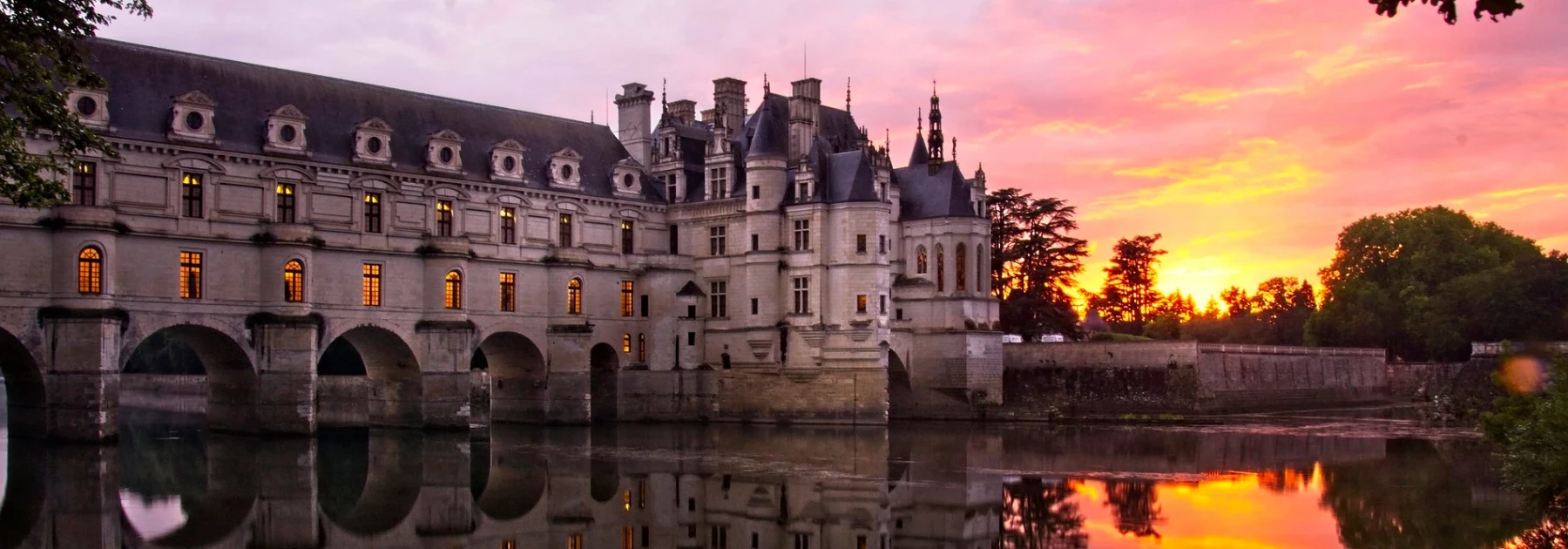To visit - The most beautiful castles in france
The castles in France stand as dazzling testimonies to the country's rich and varied history. Among them, the Palace of Versailles embodies royal grandeur with its vast halls, sumptuous French gardens, and the famous Hall of Mirrors reflecting the opulence of Louis XIV's era. Château de Chambord, a jewel of the Renaissance, distinguishes itself with spectacular architecture, including its double-helix staircase, creating a majestic masterpiece. Gracefully situated over the Cher River, Château de Chenonceau, dubbed the "Ladies' Castle," seamlessly blends Renaissance elegance with enchanting gardens.
Château de Fontainebleau, a former royal residence, provides a journey through history with architectural blends ranging from medieval to Renaissance. In Carcassonne, the medieval fortress, surrounded by imposing ramparts and crenelated towers, transports visitors into a true chivalric tale. Once Napoleon's abode, Château de Malmaison unveils elegant interiors and meticulously landscaped gardens.
Château de Vaux-le-Vicomte, a precursor to Versailles, captivates with its perfect harmony between architecture, gardens, and sculptures. In Brittany, Château de Josselin, with its graceful turrets, epitomizes medieval charm amidst picturesque nature. Renowned for its terraced gardens, Château de Villandry charms with its Renaissance architecture and refined interiors. As a former imperial residence, Château de Compiègne, surrounded by vast parks, offers a glimpse into the French imperial era.
Each castle, with its captivating history and unique architecture, is a cultural treasure, providing visitors with an immersive experience into France's rich heritage. These monuments are more than stone structures; they are living witnesses to centuries of history, power, and artistic splendor.
The 12 most beautiful castles in France :
Summary
- To visit
-
- 1 - Palace of Versailles (Versailles, Île-de-France)
- 2 - Malmaison Castle (Rueil-Malmaison, Île-de-France)
- 3 - Fontainebleau Castle (Fontainebleau, Île-de-France)
- 4 - Vaux-le-Vicomte castle (Maincy, Île-de-France)
- 5 - Chambord Castle (Chambord, Centre-Val de Loire)
- 6 - Chenonceau castle (Chenonceaux, Centre-Val de Loire)
- 7 - Saumur castle (Saumur, Pays de la Loire)
- 8 - Chantilly Castle (Chantilly, Hauts-de-France)
- 9 - Carcassonne Castle (Carcassonne, Occitanie)
- 10 - Castelnau castle (Prudhomat, Occitanie)
- 11 - Château du Haut-Kœnigsbourg (Alsace, Grand Est)
- 12 - Bonaguil Castle (Saint-Front-sur-Lémance, New Aquitaine)
- The most beautiful castles in France - Where to Stay?
- The most beautiful castles in France - How to get around?
- The most beautiful castles in France - Best period
1 - Palace of Versailles (Versailles, Île-de-France)
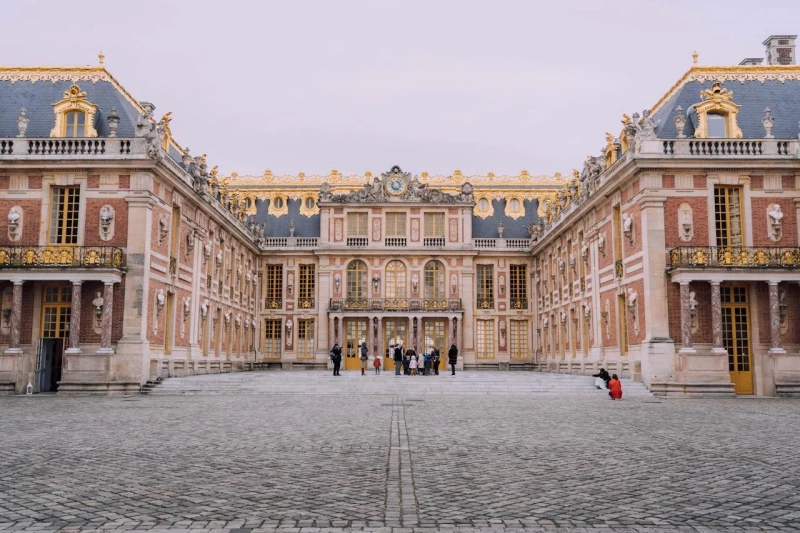
The Palace of Versailles, situated in Versailles near Paris, stands as one of France's most iconic landmarks. Construction of the palace began in 1661 under the reign of Louis XIV, the "Sun King," and evolved into a sumptuous residence over the decades. The architecture of the palace, a masterpiece of French Baroque design, features a symmetrical layout, intricate decorations, and the renowned Hall of Mirrors adorned with 357 mirrors.
The gardens of the Palace of Versailles, crafted by André Le Nôtre, are as splendid as the palace itself, boasting flowerbeds, sculptures, and fountains. The Hall of Mirrors, a venue for historical events like the signing of the Treaty of Versailles in 1919, remains one of the most famous rooms.
Within the Versailles estate lie the Grand Trianon and Petit Trianon palaces, offering more intimate residences. Versailles played a pivotal role in French political history, embodying the grandeur and opulence of the monarchy.
The Palace of Versailles attracts millions of visitors annually, allowing them to explore the State Apartments, the Hall of Mirrors, the King's and Queen's Grand Apartments, the gardens, and the Trianon palaces. Beyond its historical significance, the Palace of Versailles is an artistic and cultural testament to 17th-century France, capturing the spirit and magnificence of a bygone era. A visit provides a captivating immersion into the richness of French heritage.
 Our tips for getting the most out of your experience.
Our tips for getting the most out of your experience.
Visiting the Palace of Versailles can be a rewarding but potentially challenging experience due to the high volume of visitors. Here are some tips to optimize your visit to the Palace of Versailles:
-
Buy tickets in advance: Avoid long queues by purchasing your tickets online before your visit. This will save you time at the entrance.
-
Choose the right time of day: Visit the palace early in the morning or late in the afternoon to avoid crowds. Mornings are often quieter, especially earlier in the week.
-
Explore the gardens: The extensive gardens of Versailles are worth exploring. Allocate time to stroll through the gardens and admire the fountains, sculptures, and groves.
-
Opt for weekdays: If possible, plan your visit on a weekday to avoid the tourist influx, particularly during peak seasons.
-
Join a guided tour: A guided tour can provide in-depth information and allow you to bypass certain queues. You can choose a group tour or a private tour.
-
Use audio guides: If you prefer to explore independently, on-site audio guides will provide detailed information about different parts of the palace.
-
Be prepared for the Hall of Mirrors: The Hall of Mirrors is one of the most popular attractions. Visit it early in the morning or late in the afternoon to avoid congestion.
-
Check the fountain schedule: If you're visiting during the fountain activity period (spring and summer), make sure to check the schedule to see the fountains in action.
-
Allow enough time: The Palace of Versailles is vast, so make sure to allocate enough time to explore the palace, gardens, and possibly the Trianon palaces.
-
Stay informed about temporary exhibitions: Versailles often hosts temporary exhibitions. Check the schedule to see if a special exhibition is planned during your visit.
By following these tips, you can maximize your experience at the Palace of Versailles and fully enjoy this magnificent historical destination.
2 - Malmaison Castle (Rueil-Malmaison, Île-de-France)
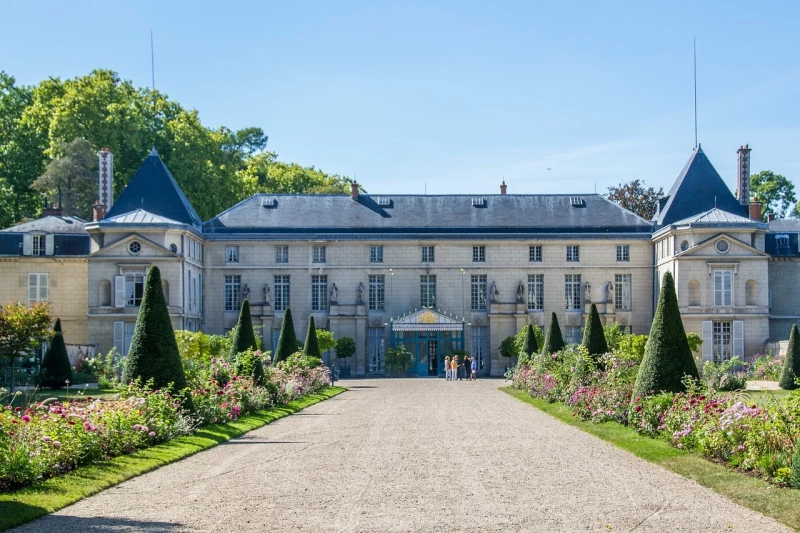
The Château de Malmaison, located in Rueil-Malmaison in the western suburbs of Paris, is a remarkable historical residence associated with Napoleon Bonaparte and his wife Josephine. Acquired by the couple in 1799, the château was transformed into an elegant home at the dawn of the 19th century. The Malmaison estate served as the principal residence for Napoleon and Josephine for several years before the fall of the Empire.
The château stands out for its Directoire style and period furniture, providing a valuable insight into daily life during the Napoleonic era. Visitors can explore various rooms in the château, including the Ambassadors' Salon, the library, and the Empress's bedroom. The gardens of Malmaison are also noteworthy, featuring rose beds that were particularly cherished by Josephine.
Beyond its role as an imperial residence, Malmaison hosted sumptuous receptions and welcomed prominent figures of the time. Today, the Château de Malmaison is a museum dedicated to the Napoleonic era, showcasing memorabilia, furniture, and artworks associated with Napoleon and Josephine. It is a must-visit for those interested in this fascinating period of French history.
 Our tips for getting the most out of your experience.
Our tips for getting the most out of your experience.
Visiting the Château de Malmaison can be a captivating experience for those interested in the history of Napoleon and Josephine. Here are some tips to enhance your visit:
-
Buy tickets in advance: Avoid queues by purchasing your tickets online in advance. This will save you time at the entrance of the château.
-
Explore the gardens: The gardens of Malmaison are beautiful and were particularly cherished by Josephine. Take the time to stroll through the gardens after touring the château.
-
Opt for a guided tour: For a more in-depth understanding of the château's history, consider joining a guided tour. Guides can share fascinating details about the lives of Napoleon and Josephine.
-
Check opening hours: Verify the château's opening hours before your visit, as they may vary depending on the season.
-
Review temporary exhibitions: Malmaison occasionally hosts temporary exhibitions. Check if there's a special exhibition during your visit.
-
Appreciate the collections: Malmaison houses collections of artworks, furniture, and personal items belonging to Napoleon and Josephine. Take the time to appreciate these historical treasures.
-
Consider combining with other sites: If time allows, consider combining your visit with other historical sites in the region, such as the Palace of Versailles or the Saint-Cloud estate.
-
Stay informed about cultural events: Keep an eye out for cultural events organized at the château, such as lectures or concerts, which could enrich your experience.
-
Respect site rules: Adhere to the rules and guidelines of the château to ensure a pleasant and respectful visit.
By following these tips, you can fully enjoy your visit to the Château de Malmaison and immerse yourself in the fascinating era of Napoleon and Josephine.
3 - Fontainebleau Castle (Fontainebleau, Île-de-France)
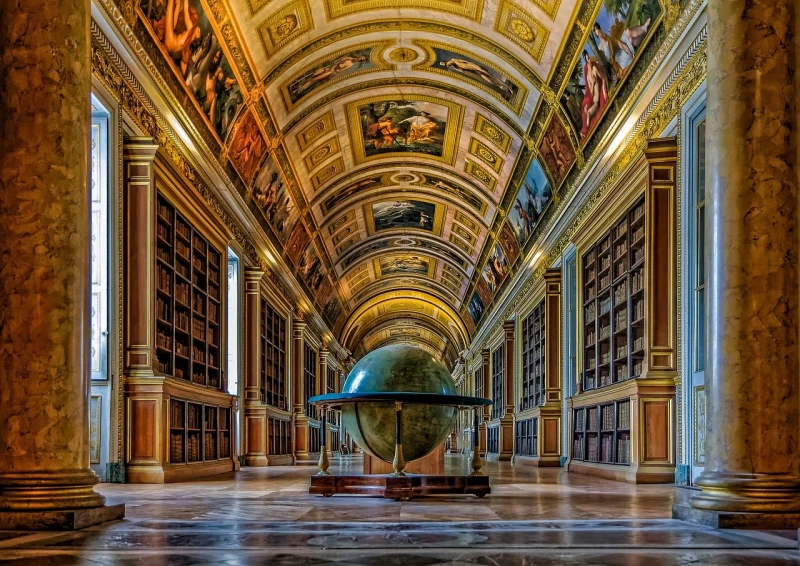
The Château de Fontainebleau, located approximately 55 kilometers southeast of Paris, is a historically significant site with over 800 years of rich history. Once a residence for French royalty, Fontainebleau has been utilized by numerous monarchs from Louis VII to Napoleon III. Its architecture reflects the evolution of styles over the centuries, spanning from medieval to Renaissance and classical influences.
The castle is renowned for its François I Gallery, an iconic work of French Renaissance art, and the Throne Room where Napoleon Bonaparte abdicated in 1814. The French formal gardens surrounding the castle provide a picturesque setting with fountains, flowerbeds, and the grand canal.
Fontainebleau has played a crucial role in artistic history, housing the École de Fontainebleau, a significant artistic center during the Renaissance. Visitors can explore the royal apartments, sumptuous reception halls, the Saint-Saturnin Chapel, and the Gallery of Diana.
Today, the Château de Fontainebleau is designated as a UNESCO World Heritage site and remains a vibrant testament to France's history. A visit offers a fascinating glimpse into the lives of French royalty across different eras and provides an unforgettable experience for history and architecture enthusiasts alike.
 Our tips for getting the most out of your experience.
Our tips for getting the most out of your experience.
To enhance your visit to the Château de Fontainebleau and fully appreciate its history and architecture, here are some practical tips:
-
Buy tickets online: Avoid queues by purchasing your tickets online in advance. This will allow you to enter the castle more quickly.
-
Visit early in the morning: To avoid crowds, consider visiting the castle early in the morning. This will provide a more peaceful experience and allow you to take photos without disturbances.
-
Join a guided tour: For a comprehensive understanding of the history and architectural details, consider participating in a guided tour. Guides can provide enriching information.
-
Explore the gardens: Take the time to explore the beautiful French gardens surrounding the castle. The fountains, flowerbeds, and grand canal are worth a visit.
-
Check the cultural program: See if there are temporary exhibitions, concerts, or other special events scheduled during your visit. This could enhance your experience.
-
Allocate enough time: The castle is extensive and rich in history. Allocate enough time to explore the various rooms, royal apartments, and gardens without feeling rushed.
-
Download a mobile app: Some castles offer mobile apps to guide your visit with interactive information. Check if the Château de Fontainebleau has one.
-
Respect the castle rules: Follow the guidelines and rules of the castle to ensure a pleasant and respectful visit to the historic site.
-
Bring a water bottle: The visit can be lengthy, especially if you explore the gardens. Ensure you have water with you to stay hydrated.
By following these tips, you can fully enjoy your visit to the Château de Fontainebleau and gain a deeper understanding of this exceptional historical site.
4 - Vaux-le-Vicomte castle (Maincy, Île-de-France)
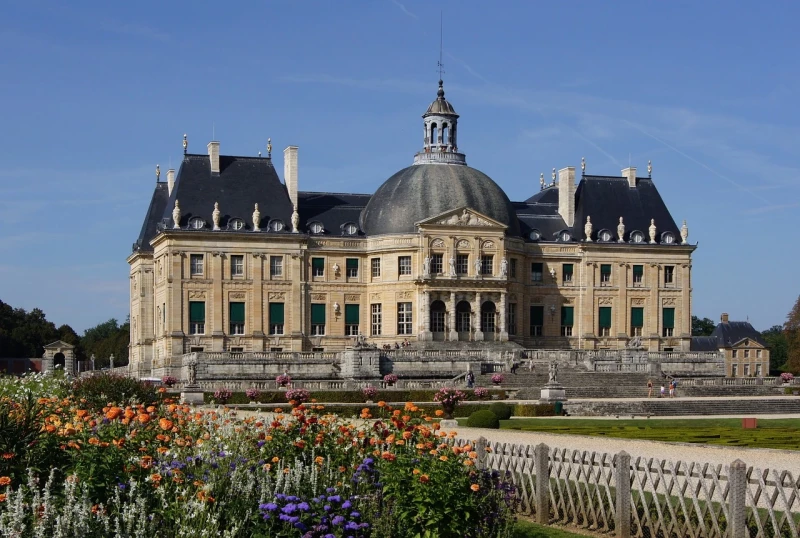
The Château de Vaux-le-Vicomte, located approximately 50 kilometers southeast of Paris, is a 17th-century architectural masterpiece. Built between 1658 and 1661 by Louis XIV's finance superintendent, Nicolas Fouquet, the castle epitomizes the pinnacle of French classical style. Designed by architect Louis Le Vau, landscape artist André Le Nôtre, and painter-decorator Charles Le Brun, Vaux-le-Vicomte stands as a perfect example of the art of the Grand Siècle.
The castle is renowned for its harmonious blend of architecture, gardens, and sumptuous interiors. The centerpiece, the Grand Perspective, extends from the castle's terrace, providing a spectacular view of Le Nôtre's French gardens.
However, Vaux-le-Vicomte's fate was marked by Fouquet's downfall. In 1661, King Louis XIV, envious of the magnificence of the castle, imprisoned Fouquet and appropriated the artists and craftsmen of Vaux-le-Vicomte to build the Palace of Versailles.
Today, the Château de Vaux-le-Vicomte is open to the public, allowing visitors to admire the elegance of its architecture, the grandeur of its gardens, and appreciate the fascinating history intertwined with the rivalry between Fouquet and Louis XIV. It is a must-visit destination for those looking to immerse themselves in the golden age of French art and architecture.
 Our tips for getting the most out of your experience.
Our tips for getting the most out of your experience.
To make the most of your visit to Château de Vaux-le-Vicomte and fully appreciate its splendor, here are some practical tips:
-
Arrive early: To avoid crowds, arrive early in the morning. This will give you the opportunity to explore the castle and its gardens more peacefully.
-
Opt for a guided tour: Guided tours can provide detailed information about the history of the castle, its architecture, and the key figures who influenced its fate. This can enrich your experience.
-
Explore the gardens: Don't overlook the magnificent gardens designed by André Le Nôtre. The perspective from the terrace is particularly impressive.
-
Attend special events: Vaux-le-Vicomte sometimes hosts special events, concerts, fireworks, etc. Check the schedule to see if there's anything particular happening during your visit.
-
Enjoy evening visits: On certain evenings, the castle is illuminated during evening visits. It's a unique way to experience Vaux-le-Vicomte in a different atmosphere.
-
Learn about the history of the castle: Before your visit, familiarize yourself with the history of Vaux-le-Vicomte to better appreciate the details and anecdotes during your exploration.
-
Allocate enough time: The castle and its gardens are extensive, so make sure to allocate enough time to see everything without rushing.
-
Picnic in the park: If the weather is favorable, bring a picnic and enjoy the green spaces of the park for a relaxing break.
-
Check opening hours: Ensure you know the opening hours of the castle and gardens to plan your visit efficiently.
By following these tips, you'll be better prepared to explore Château de Vaux-le-Vicomte and immerse yourself in its fascinating history.
5 - Chambord Castle (Chambord, Centre-Val de Loire)

The Château de Chambord, located in the Loire Valley of France, is an iconic architectural masterpiece of the French Renaissance. Constructed under the reign of François I starting in 1519, the castle stands out for its unique blend of Gothic, Italian Renaissance, and medieval elements. Designed by the Italian architect Leonardo da Vinci, the château is characterized by its towers, imposing chimneys, and the famous double-helix staircase.
Chambord was primarily used as a hunting lodge by the kings of France. The grandeur of its rooms, the majesty of its terraces, and the complexity of its decorations make it an exceptional example of Renaissance architecture. The lantern-like rooftops and numerous sculpted chimneys give the castle a distinctive silhouette.
The estate surrounding Chambord includes an extensive wooded park and a hunting enclosure. Visitors can explore the formal French gardens, observe local wildlife, and enjoy the panoramic views from the castle's terraces.
Now classified as a UNESCO World Heritage site, the Château de Chambord is one of the most visited sites in the Loire Valley. A visit provides a fascinating dive into the history of the Renaissance and the visionary spirit of the era.
 Our tips for getting the most out of your experience.
Our tips for getting the most out of your experience.
To make the most of your visit to Château de Chambord and have an enriching experience, here are some practical tips:
-
Purchase tickets online: Avoid queues by buying your tickets online in advance. This will allow you to enter the castle more quickly.
-
Opt for a guided tour: A guided tour can provide in-depth information about the history, architecture, and anecdotes related to the castle. This can make your visit more captivating.
-
Explore the rooftop terrace: Don't miss the chance to explore the rooftop terrace of the castle, which offers a panoramic view of the surroundings. It's an ideal spot for taking photos.
-
Discover the double-helix staircase: The famous double-helix staircase designed by Leonardo da Vinci is a masterpiece of the castle. Take the time to admire it and learn more about its ingenious design.
-
Participate in special events: Check the calendar for special events organized at the castle, such as temporary exhibitions, concerts, or other activities. This can add a unique dimension to your visit.
-
Explore the gardens and park: Take the time to stroll through the formal French gardens and explore the vast park surrounding the castle. It's an opportunity to experience the surrounding nature.
-
Check guided tour schedules: If you prefer to explore the castle with a guide, make sure to know the schedules of guided tours and plan accordingly.
-
Allocate enough time: Château de Chambord is vast, so make sure you have enough time to explore the castle and its surroundings without feeling rushed.
By following these tips, you'll be better prepared to fully enjoy your visit to Château de Chambord and discover everything this exceptional site has to offer.
6 - Chenonceau castle (Chenonceaux, Centre-Val de Loire)
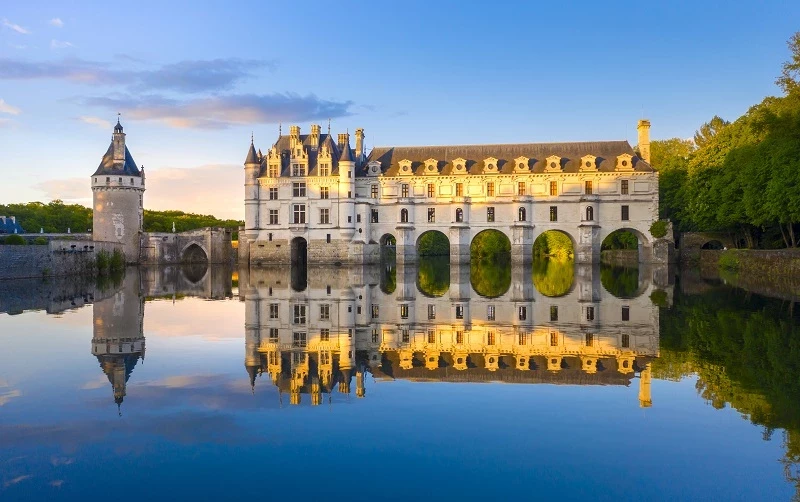
The Château de Chenonceau, located in the Loire Valley in France, stands out as one of the most iconic castles in the region. Built in the 16th century over the Cher River, it is distinguished by its elegance and exceptional beauty. Often referred to as the "Ladies' Castle," Chenonceau bears the marked influence of several women in its history, most notably Diane de Poitiers and Catherine de Medici.
The castle is characterized by its unique structure spanning the river, creating an iconic image of the castle above the water. The meticulously maintained French gardens surrounding it add to its charm, featuring carefully landscaped flower beds and striking perspectives.
The interior of Château de Chenonceau is richly decorated, housing a remarkable collection of period furniture, tapestries, and paintings. The gallery that spans the river is one of the highlights, providing a spectacular view of the surrounding landscape.
Chenonceau has witnessed numerous historical events, and its romantic ambiance makes it a favorite destination for visitors. Its fascinating history and remarkable architecture make it a must-visit in the Loire Valley, designated as a UNESCO World Heritage site.
 Our tips for getting the most out of your experience.
Our tips for getting the most out of your experience.
To fully enjoy your visit to Château de Chenonceau and appreciate all its aspects, here are some practical tips:
-
Buy tickets online: Avoid queues by purchasing your tickets online in advance. This will allow you to enter the castle more quickly.
-
Choose the right time of day: Early morning or late afternoon can be an ideal time to visit the castle with fewer visitors, providing a more peaceful experience.
-
Opt for a guided tour: To learn more about the rich history of the castle, consider joining a guided tour. Guides can provide interesting information about architectural details and the notable figures associated with Chenonceau.
-
Explore the gardens: Take the time to stroll through the French gardens surrounding the castle. The various landscaped areas offer a beautiful variety of perspectives.
-
Visit the gallery over the river: Don't miss the gallery that spans the river. The view from this iconic spot is breathtaking and is one of the most famous features of the castle.
-
Check the schedule for special events: See if there are special events, temporary exhibitions, or performances scheduled during your visit. This can add an extra dimension to your experience.
-
Allocate enough time: Château de Chenonceau is rich in history and details, so make sure you have enough time to explore the castle, its gardens, and the surrounding areas.
-
Respect site rules: Follow the castle's guidelines to ensure a pleasant and respectful visit.
By following these tips, you can fully appreciate the beauty and captivating history of Château de Chenonceau.
7 - Saumur castle (Saumur, Pays de la Loire)
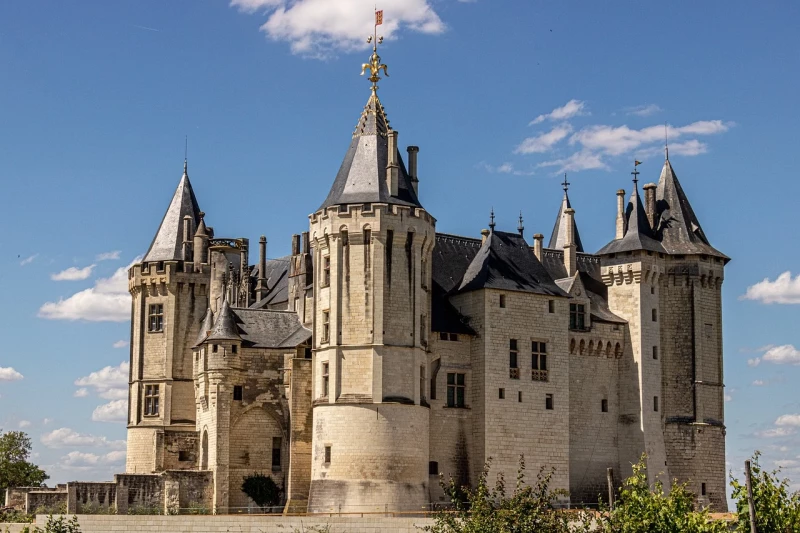
The Château de Saumur, located in the city of Saumur in the Loire Valley of France, is a remarkable historical fortress with a rich tapestry of history. Built in the 10th century, the castle has undergone several transformations over the centuries, blending medieval and Renaissance elements. Perched on a rocky promontory, it provides panoramic views of the town and the Loire River.
The Château de Saumur houses the Museum of Decorative Arts, showcasing a diverse collection of art objects, furniture, and sculptures. Visitors can explore its lavishly decorated rooms, delve into the military history of the region, and appreciate the variety of temporary exhibitions.
The castle's gardens, featuring flower beds and terraces, add to the picturesque allure of the ensemble. The elegant silhouette of the castle, characterized by its towers and battlements, makes it an iconic site in the Loire Valley.
Today, the Château de Saumur attracts history enthusiasts, architecture aficionados, and art lovers, offering a captivating glimpse into the region's past and serving as a living testament to its rich heritage.
 Our tips for getting the most out of your experience.
Our tips for getting the most out of your experience.
For a pleasant and enriching visit to the Château de Saumur, here are some practical tips:
-
Buy tickets online: Avoid queues by purchasing your tickets online in advance. This will save you time at the entrance of the castle.
-
Opt for a guided tour: For a better understanding of the castle's history and its collections, consider joining a guided tour. Guides can provide detailed information and interesting anecdotes.
-
Explore the gardens: Take the time to stroll through the castle gardens. The terraces offer magnificent views of the town and the Loire Valley.
-
Check opening hours: Make sure you know the castle's opening hours before your visit to plan your day efficiently.
-
Review the events program: Check if there are special events, temporary exhibitions, or cultural activities scheduled during your visit. This can add a unique dimension to your experience.
-
Allocate time for the museum: The Museum of Decorative Arts inside the castle deserves special attention. Ensure you have enough time to explore its diverse collections.
-
Wear comfortable shoes: Exploring the castle may involve climbing stairs and navigating sometimes uneven spaces. Comfortable shoes are recommended.
-
Respect the castle's guidelines: Follow the castle rules to ensure a pleasant and respectful visit to the historical site.
By following these tips, you'll be better prepared to fully enjoy your visit to the Château de Saumur and explore its rich heritage.
8 - Chantilly Castle (Chantilly, Hauts-de-France)
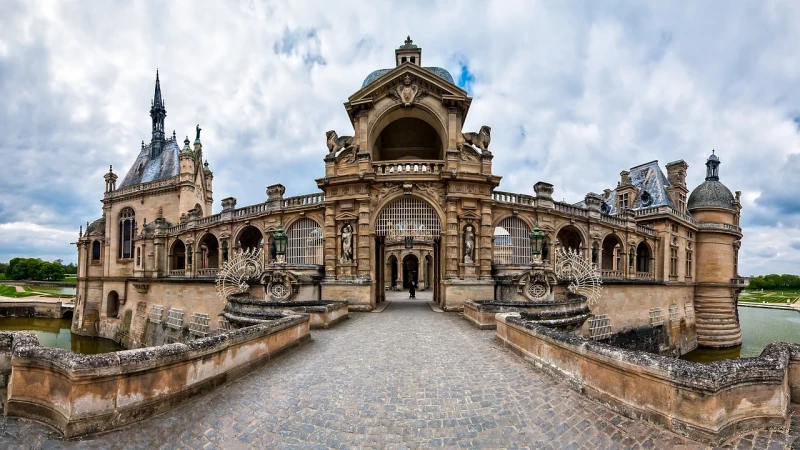
The Château de Chantilly, located in the Hauts-de-France region of France, is a magnificent historical residence surrounded by an extensive wooded estate. Built in the 16th century, the castle underwent significant expansions and enhancements over the centuries, reaching its zenith in the 19th century under the Duke of Aumale. It showcases a harmonious blend of architectural styles, ranging from Gothic to Renaissance.
The castle is home to the renowned Chantilly Library, housing an exceptional collection of medieval manuscripts and rare books. Visitors can also admire sumptuous ceremonial rooms, including the Gallery of Actions of Monsieur le Prince and the Monkey Salon.
Chantilly's park, designed by André Le Nôtre in the 17th century, is one of the largest and most picturesque in France. The gardens include a French-style garden, an English garden, and the famous Hameau de la Reine, inspired by Marie Antoinette's hamlet at Versailles.
Today, the Château de Chantilly is a major cultural destination, hosting the Condé Museum, which displays a rich collection of artworks, paintings, and sculptures. The castle and its estate offer a timeless getaway, captivating visitors with their history, remarkable architecture, and the natural beauty of their surroundings.
 Our tips for getting the most out of your experience.
Our tips for getting the most out of your experience.
To enhance your visit to the Château de Chantilly and appreciate every aspect, here are some practical tips:
-
Purchase tickets online in advance: Avoid waiting in lines by buying your tickets online. This will allow you to enter the castle more quickly.
-
Opt for a guided tour: For a thorough understanding of the castle's history and its collections, consider joining a guided tour. Guides can provide detailed and interesting information.
-
Explore the park and gardens: Allocate time to discover the extensive gardens and the French-style park designed by André Le Nôtre. The Hameau de la Reine is particularly charming.
-
Visit the Chantilly Library: The castle's library houses an exceptional collection of manuscripts and rare books. Make sure to take a tour to admire these treasures.
-
Discover temporary exhibitions: Check the schedule for temporary exhibitions that can offer a unique perspective on art and history.
-
Attend special events: See if special events, concerts, or cultural performances are scheduled during your visit.
-
Allocate time for the Musée Condé: The museum houses a rich collection of artworks. Ensure you have enough time to explore it.
-
Check opening hours: Make sure you know the opening hours of the castle and the museum to plan your visit optimally.
By following these tips, you'll be better prepared to appreciate the beauty, history, and cultural richness of the Château de Chantilly.
9 - Carcassonne Castle (Carcassonne, Occitanie)
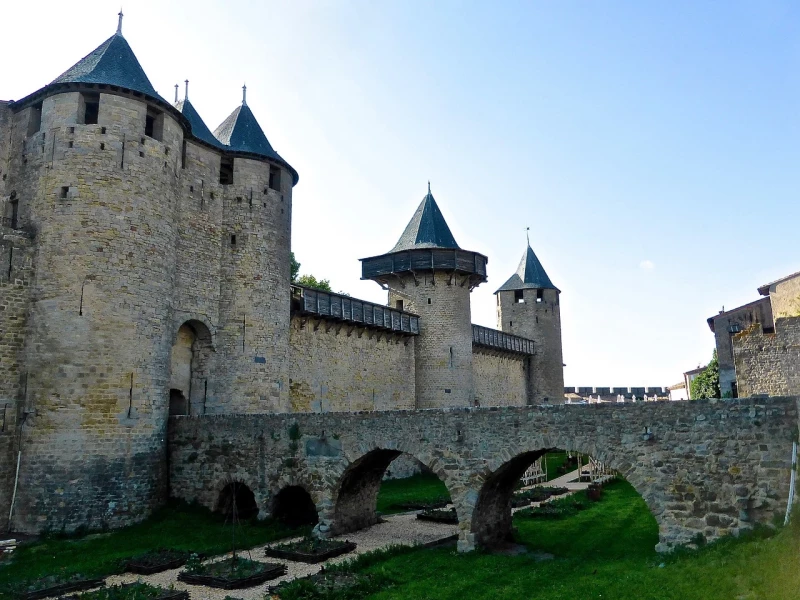
The Château de Carcassonne, located in the medieval city of Carcassonne in southern France, is an iconic fortress that encapsulates medieval history and charm. Built on a rocky promontory, the castle is an exceptional example of medieval military architecture, featuring imposing towers and well-preserved ramparts.
The site has witnessed periods of occupation since Roman times, but the current structure is largely credited to the 19th-century restoration work by the architect Eugène Viollet-le-Duc. The castle is surrounded by double walls and towers that offer breathtaking views of the surrounding region, including the Aude Valley.
Within the ramparts, visitors can wander through cobbled streets, discover the Basilica of Saint-Nazaire, and explore the Château Comtal, which houses a museum on the history of Carcassonne. The ramparts themselves provide an immersive experience, offering panoramic views of the medieval city and the surrounding landscape.
Listed as a UNESCO World Heritage site, the Château de Carcassonne attracts visitors from around the world, transporting them to a distant era when knights and dungeons reigned supreme. It remains a fascinating testament to medieval fortified architecture and the cultural heritage of the region.
 Our tips for getting the most out of your experience.
Our tips for getting the most out of your experience.
To make the most of your visit to the Château de Carcassonne, here are some practical tips:
-
Arrive early or late in the day: To avoid crowds, plan your visit early in the morning or late in the day. This will allow you to better appreciate the peaceful atmosphere of the medieval citadel.
-
Purchase tickets online: Skip the lines by buying your tickets online in advance. This will enable you to access the castle more quickly.
-
Opt for a guided tour: A guided tour can enhance your experience by providing in-depth information about the history of the castle and the medieval citadel. Guides often share fascinating anecdotes.
-
Explore the ramparts: Take the time to walk along the ramparts to enjoy panoramic views of the citadel and the surrounding area. It's also an excellent way to discover the fortified architecture.
-
Visit the Basilica of Saint-Nazaire: Explore the basilica located within the citadel. It houses interesting architectural and artistic elements.
-
Allocate time for the museum: The Château Comtal houses a museum that traces the history of Carcassonne. Make sure to allow enough time to explore the exhibitions.
-
Wander through picturesque alleys: Get lost in the cobbled streets of the medieval citadel. This will allow you to discover charming corners and unique views.
-
Check the schedule for animations: See if there are any performances, shows, or special events scheduled during your visit. This can add a special touch to your experience.
By following these tips, you'll be better prepared to have a memorable visit to the Château de Carcassonne and explore this unique medieval citadel.
10 - Castelnau castle (Prudhomat, Occitanie)
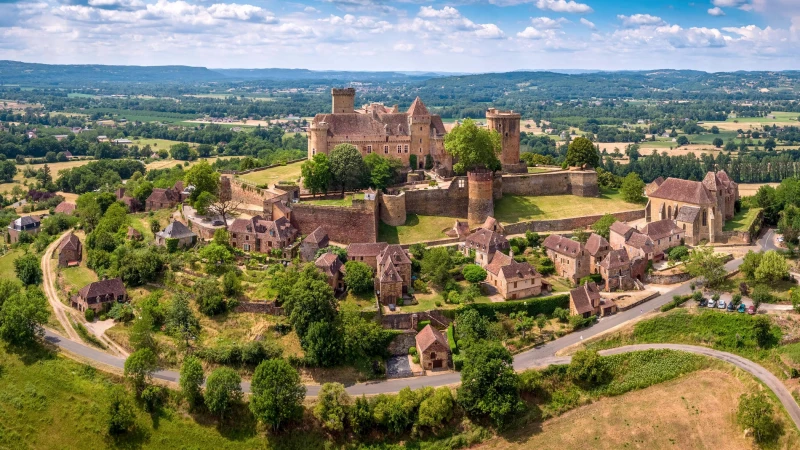
The Château de Castelnau, located in the Dordogne Valley in France, is a magnificent example of a medieval fortress perched on a hill. Built in the 13th century, this imposing castle provides a striking glimpse into the defensive architecture of the time. With its towering turrets and well-preserved ramparts, it bears witness to the tumultuous history of the region.
The castle underwent restoration in the 19th century, preserving its medieval appearance while adding a touch of romanticism. Visitors can explore its lavishly furnished rooms, vaulted passages, and watchtower, each offering a glimpse into medieval life.
Situated in the heart of a region renowned for its castles, Castelnau stands out with its picturesque location, providing panoramic views of the Dordogne Valley. The castle also houses a collection of armor, weapons, and medieval artifacts, offering a captivating insight into the military and daily life of the time.
Listed as a historical monument, the Château de Castelnau attracts visitors with its preserved medieval charm, impressive silhouette, and its role in the tumultuous history of the region. It is a must-visit for history enthusiasts and medieval heritage aficionados.
 Our tips for getting the most out of your experience.
Our tips for getting the most out of your experience.
To make the most of your visit to Château de Castelnau, here are some practical tips:
-
Buy tickets online: Save time by purchasing your tickets online in advance. This will help you avoid lines at the entrance of the castle.
-
Opt for a guided tour: Guided tours can provide in-depth information about the castle's history, architecture, and interesting anecdotes from its past. It's an excellent way to enrich your experience.
-
Explore at your own pace: Take the time to explore every corner of the castle at your own pace. Admire the architecture, explore furnished rooms, and climb the towers for panoramic views.
-
Appreciate panoramic views: Don't miss the opportunity to climb the towers for spectacular views of the Dordogne Valley and the surrounding area. It's one of the highlights of the castle.
-
Check for temporary exhibitions: See if there are temporary exhibitions or special events scheduled during your visit. This can add an extra dimension to your experience.
-
Discover the collections: Explore the castle's collections, including armor, weapons, and medieval artifacts. It will give you insight into medieval life.
-
Take photos: Remember to bring your camera to capture memorable moments and the beautiful views of the castle and its surroundings.
-
Check opening hours: Make sure you know the castle's opening hours to plan your visit optimally.
By following these tips, you'll be better prepared to fully appreciate the beauty and captivating history of Château de Castelnau.
11 - Château du Haut-Kœnigsbourg (Alsace, Grand Est)
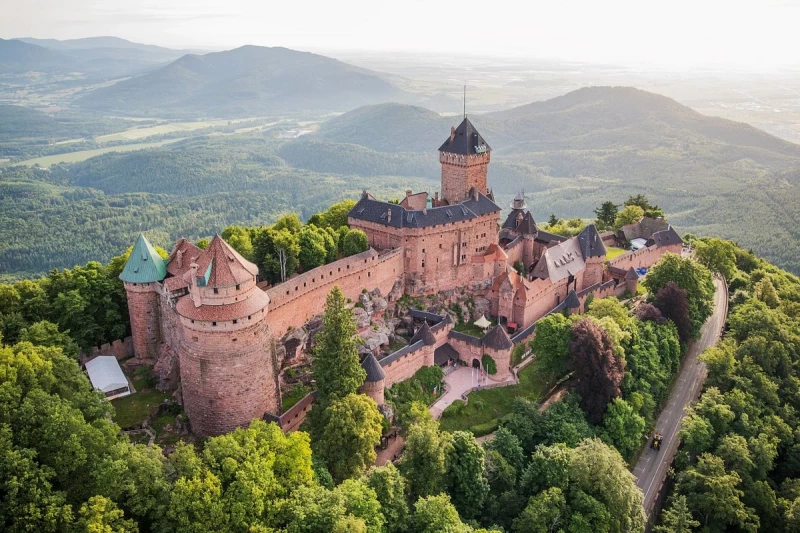
Perched majestically on a hill in the Vosges Mountains of Alsace, the Haut-Kœnigsbourg Castle is a masterpiece of medieval architecture that transports visitors through the centuries. Built in the 12th century, the castle underwent restoration in the 20th century to regain its original appearance, complete with turrets, battlements, and imposing walls.
Visitors can explore different parts of the castle, from inner courtyards to lavishly decorated rooms. The view from the ramparts offers a spectacular panorama of the surrounding landscapes, including the Alsatian vineyards and the Black Forest.
With a rich history, the Haut-Kœnigsbourg has witnessed various eras, from the medieval period to modern wars. Exhibitions inside the castle detail its tumultuous history and shed light on daily life during different periods.
With its strategic location, impressive architecture, and historical significance, the Haut-Kœnigsbourg Castle has become one of Alsace's most iconic sites, attracting visitors from around the world for an immersive journey into the region's medieval past.
 Our tips for getting the most out of your experience.
Our tips for getting the most out of your experience.
To make the most of your visit to the Haut-Kœnigsbourg Castle, here are some practical tips:
-
Purchase tickets online: Save time by buying your tickets online in advance to avoid queues at the castle entrance.
-
Plan your visit early morning or late afternoon: To enjoy the tranquility and special lighting, consider visiting early in the morning or late in the afternoon.
-
Opt for a guided tour: Guided tours can provide in-depth information about the castle's history, architecture, and fascinating anecdotes. Some tours may also include access to less crowded areas.
-
Explore the ramparts: Don't miss the opportunity to climb the ramparts for spectacular panoramic views of the surroundings.
-
Attend a demonstration: On certain days, the castle offers demonstrations of medieval life, such as weapon presentations or craft workshops. Check the event calendar before your visit.
-
Allocate time for the museum: The castle houses a museum that provides in-depth information about its history and the various eras it has experienced. Allocate enough time for this.
-
Bring water and snacks: The visit may take some time, and having water and snacks with you can be convenient, especially if you plan to stay for a while.
-
Wear comfortable shoes: Exploring the castle may involve walking on uneven surfaces. Comfortable shoes are recommended.
By following these tips, you'll be better prepared to fully appreciate the beauty and captivating history of the Haut-Kœnigsbourg Castle.
12 - Bonaguil Castle (Saint-Front-sur-Lémance, New Aquitaine)
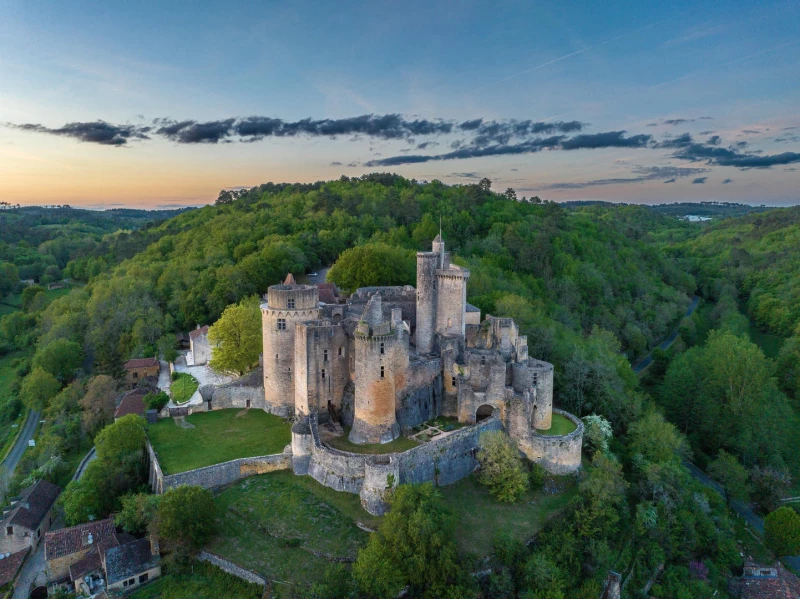
The Château de Bonaguil, located in the Lot-et-Garonne region of France, is a medieval architectural masterpiece nestled in the heart of a picturesque landscape. Built during the 13th and 15th centuries, the castle was strategically designed for defensive purposes, showcasing the ingenuity of architects of the time. With its imposing towers, moats, and ramparts, Bonaguil stands as an impressive example of medieval fortification.
Over the centuries, the castle underwent modifications and additions, resulting in an eclectic combination of architectural styles. Visitors can wander through various courtyards, climb the spiral staircases of the towers, and explore underground passages, uncovering the multiple facets of this citadel.
The panoramic view from the ramparts provides a spectacular sight of the surrounding countryside. In addition to its historical significance, Bonaguil is also appreciated for its mystical and romantic ambiance. Classified as a historical monument, it attracts visitors from around the world who come to marvel at this architectural wonder preserved through the centuries.
 Our tips for getting the most out of your experience.
Our tips for getting the most out of your experience.
For an optimal visit to Château de Bonaguil, here are some practical tips:
-
Purchase tickets online: Save time by buying your tickets online in advance to avoid queues at the castle entrance.
-
Opt for a guided tour: A guided tour can provide in-depth information about the history and architecture of the castle. Guides can also share interesting anecdotes that enhance the experience.
-
Explore at your own pace: The castle offers numerous corners to discover. Take the time to explore each part at your own pace, especially the towers, underground passages, and courtyards.
-
Appreciate the view from the ramparts: Don't miss the opportunity to climb the ramparts for a panoramic view of the surroundings. It's an excellent opportunity for memorable photos.
-
Check opening hours: Make sure you know the castle's opening hours to plan your visit accordingly.
-
Listen to audio commentary: If audio commentary is available, use it to gain additional insights while exploring the castle.
-
Bring water and snacks: Bring water and snacks, especially if you plan to spend a significant amount of time exploring the castle. Some areas may be distant from amenities.
-
Inquire about special events: Check if there are special events, historical reenactments, or temporary exhibitions scheduled during your visit.
By following these tips, you'll be better prepared to fully enjoy your experience at Château de Bonaguil.
The most beautiful castles in France - Where to Stay?
Choosing where to stay to visit the most beautiful castles in France depends on the specific region you wish to explore. Here are some general suggestions based on regions where some of the most famous castles are located:
-
Loire Valley Region: The Loire Valley is famous for its stunning castles like Chambord, Chenonceau, and Villandry. Consider staying in cities like Tours, Blois, Amboise, or Saumur, which are well-positioned to explore the castles in the region.
-
Alsace Region: If you plan to visit castles in Alsace like the Haut-Kœnigsbourg Castle, you might choose to stay in cities like Strasbourg, Colmar, or Sélestat.
-
Normandy Region: If you want to explore castles in Normandy like Fontaine-Henry Castle, you could opt to stay in cities like Caen, Bayeux, or Rouen.
-
Île-de-France Region: To visit castles near Paris such as Versailles or Fontainebleau, staying in Paris itself would be a convenient option. You could also consider nearby cities like Versailles or Fontainebleau.
-
Burgundy Region: To explore castles in Burgundy like Ancy-le-Franc, you might choose to stay in cities like Dijon or Beaune.
-
Provence-Alpes-Côte d'Azur Region: If you intend to visit castles in the south of France, such as Château de La Napoule, cities like Nice, Cannes, or Grasse could be suitable bases.
It's also important to consider your mode of transportation, whether it's by car, train, or plane, to facilitate your travel between castles. Choose a city or region that offers convenient access to several castles you wish to visit.
The most beautiful castles in France - How to get around?
The mode of transportation to visit the most beautiful castles in France depends on your situation, the region you want to explore, and your preferences. Here are some common options:
-
By car: If you have the option to rent a car, it provides maximum flexibility to explore regions and visit castles. You can create your own itinerary, access more remote locations, and tailor your schedule according to your preferences.
-
By train: For some regions, especially the Loire Valley or Île-de-France (around Paris), trains can be a convenient option. You can take a train to a central city and use local transportation, shuttles, or rent a car to visit the castles.
-
By bus or organized tour: Many tourist regions offer bus tours or organized visits that include multiple castles. This can be a convenient option if you prefer not to drive yourself.
-
By bicycle: In some regions, like the Loire Valley, biking can be a pleasant and eco-friendly option. Many castles are located at a reasonable distance from each other, and you can enjoy the scenery during your travels.
-
By plane: If you plan to visit castles in different regions of France, you might consider taking a plane for longer distances. However, this may be less convenient for visiting specific castles as airports can be distant.
-
By local public transportation: In certain regions, you may use local public transportation, such as buses or trams, to travel between castles, especially in more urbanized areas.
It's recommended to plan your itinerary in advance, considering the distances between castles, available transportation options in the region, and your personal travel preferences.
The most beautiful castles in France - Best period
The best time to visit the most beautiful castles in France depends on your preferences regarding weather, crowds, and specific events in the region you want to explore. Here are some general tips:
-
Spring (April to June): Spring usually offers pleasant weather with moderate temperatures. The castle gardens are often in full bloom, adding to the beauty of the visits. However, it is also a period when sites can be more crowded, especially in May and June.
-
Summer (July to August): Summer is the high tourist season in France. Days are long, the castles can be very crowded, but the weather is generally sunny and warm. It is advisable to book your tickets in advance and visit the castles early in the morning or late in the afternoon to avoid crowds.
-
Fall (September to November): Fall offers pleasant temperatures and fewer crowds compared to summer. Autumn colors can make the landscapes even more picturesque. It's an ideal time to visit castles without being too bothered by heat or crowds.
-
Winter (December to February): If you prefer quieter conditions, winter can be an option. However, note that some castles may have reduced hours during this period, and the weather can be cold, especially in the northern regions of France.
-
Special Events: Some times of the year may coincide with special events, festivals, exhibitions, or Christmas markets near the castles. If you are interested in these activities, check local calendars.
In summary, spring and fall are often considered the best seasons to visit castles due to pleasant weather conditions and moderate tourist traffic. However, each season has its advantages, and the choice depends on your personal preferences.
